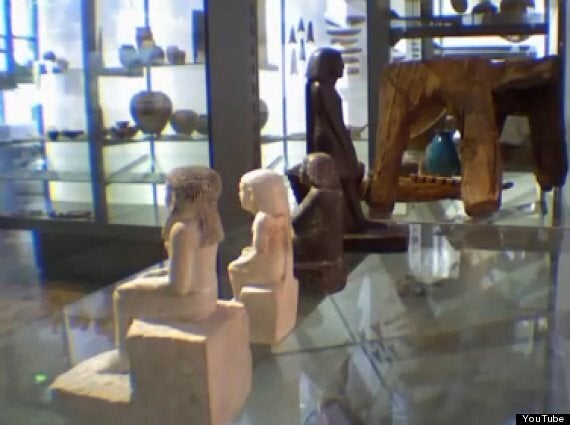Eerie footage of an ancient Egyptian statue mysteriously spinning around in its glass display case has emerged.
The 10-inch tall figurine of Neb-Senu – which dates back to 1800 BC – was found in a mummy’s tomb and has been on display at Manchester Museum for 80 years.
But this is the first time it has ever done this…

The statue of Neb-Senu (dark stone) has been filmed spinning 180 degrees
Time-lapse video filmed over the course of a week shows the relic spinning, apparently of its own volition, as visitors mill around.
But by night, 4,000 year-old Neb-Senu, which was originally an offering to Osiris, the god of the dead and ruler of the underworld, is still.
Writing on the Egypt at the Manchester Museum blog, curator Campbell Price says: "The cause may be subtle vibrations from football or traffic outside, but the statuette has been on a glass shelf in about the same place in the gallery for decades and has never moved before - and none of the other objects in the case move in any way. A mystery? See for yourself."
Price hints the museum may have been struck by the infamous “curse of the Pharaohs,” which is said to affect anyone who disturbs a mummy or Pharaoh's tomb.
He told the Manchester Evening News: “I noticed one day that it had turned around. I thought it was strange because it is in a case and I am the only one who has a key.
SEE ALSO:
“I put it back but then the next day it had moved again. We set up a time-lapse video and, although the naked eye can’t see it, you can clearly see it rotate on the film. The statuette is something that used to go in the tomb along with the mummy.
“Mourners would lay offerings at its feet. The hieroglyphics on the back ask for ‘bread, beer and beef’.
“In Ancient Egypt they believed that if the mummy is destroyed then the statuette can act as an alternative vessel for the spirit. Maybe that is what is causing the movement.”
Yet TV physicist Brian Cox, who teaches at the university, is not convinced – and believes differential friction is the scientific explanation for the spooky spinning.
“Brian thinks its differential friction, where two surfaces – the serpentine stone of the statuette and glass shelf it is on – cause a subtle vibration which is making the statuette turn,” Price told The Independent.
He added: “But it has been on those surfaces since we have had it and it has never moved before. And why would it go around in a perfect circle? ”